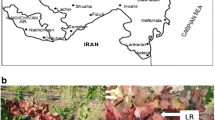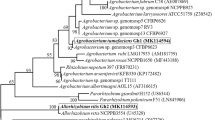Abstract
Aureobasidium isolated from Vitis vinifera (cv Chardonnay) grapevine tissues were characterised using morphological and molecular techniques. Species level identification of 29 isolates was accomplished by partial amplification and sequencing of the ITS region (ITS1–5.8S–ITS2) using universal primers ITS1 and ITS4. A comparison of nucleotide sequences using BLAST followed by phylogenetic analysis revealed that all isolates examined were Aureobasidium pullulans. Strain level discrimination of a total of 100 epiphytic Aureobasidium isolates including three reference strains was successfully carried out using two inter simple sequence repeat (ISSR) primers, (AAC)5 and (GTG)5 and the Intron Splice Junction R1 (ISJ-R1) primer in which 24, 24 and 15 scorable bands were produced for each primer, respectively. The high level of genetic variation recorded among the isolates further highlighted the high levels of strain diversity among A. pullulans residing on grapevines. Thirty-two epiphytic Aureobasidium isolates were examined for their ability to inhibit the growth of Greeneria uvicola, responsible for bitter rot of grapes. Using an in-vitro dual-culture antagonism assay, all isolates inhibited the growth of G. uvicola (Isolates DAR 77272 and DAR 77273) with inhibition ranging from 15 to 85%. Three Aureobasidium isolates were then examined for their ability to inhibit G. uvicola when co-inoculated onto detached berries, leaves and grape bunches growing on potted vines in a glass house. All isolates reduced the severity of bitter rot infection. The results indicate that A. pullulans has the potential to suppress bitter rot of grapes.






Similar content being viewed by others
References
Abu-Ghosh, S., Droby, S., & Korine, C. (2014). Seasonal and plant-dependent variation in diversity, abundance and stress tolerence of epiphytic yeasts in desert habitats. Environmental Microbiology Reports, 6, 373–382.
Adikaram, N. K. B., Joyce, D. C., & Terry, A. L. (2002). Biocontrol activity and induced resistance as a possible mode of action for Aureobasidium pullulans against grey mould of strawberry fruit. Australasian Plant Pathology, 31(3), 223–229.
Arzanlou, M. (2014). Molecular characterization of Aureobasidium species in Iran. Research in. Molecular Medicine, 2, 28–33.
Barata, A., Malfeito-Ferreira, M., & Loureiro, V. (2012). The microbial ecology of wine grape berries. International Journal of Food Microbiology, 153(3), 243–259.
Barbetti, M. J. (1980). Bunch rot of Rhine Riesling grapes in the lower south-west of Western Australia. Australian Journal of Experimental Agriculture and Animal Husbandry, 20, 247–251.
Barnett, H. L., & Hunter, B. B. (1998). Illustrated genera of imperfect fungi (4th ed.). St. Paul: APS Press.
Castoria, R., De Curtis, F., Lima, G., & De Cicco, V. (2001). Aureobasidium pullulans (LS-30) an antagonist of postharvest pathogens of fruit, study on its modes of action. Postharvest Biology and Technology, 22, 7–17.
Coombe, B. G. (1995). Adoption of a system for identifying grapevine growth stages. Australian Journal of Grape and Wine Research, 1(2), 100–110.
De Curtis, F., Caputo, L., Castoria, R., Lima, G., Stea, G., & De Cicco, V. (2004). Use of fluorescent amplified fragment length polymorphism (fAFLP) to identify specific molecular markers for the biocontrol agent Aureobasidium pullulans strain LS30. Postharvest Biology and Technology, 34, 179–186.
De Curtis, F., De Felice, D. V., De Cicco, V., & Lima, G. (2012a). Efficacy of biocontrol yeasts combined with calcium silicate or sulphur for controlling durum wheat powdery mildew and increasing grain yield components. Field crop reserch, 134, 36–46.
De Curtis, F., De Felice, D. V., Ianiri, G., De Cicco, V., & Castorio, R. (2012b). Environmental factors affect the activity of biocontrol agents against ocharatoxigenic Aspergillus carbonarius on wine grape. International Journal of Food Microbiology, 159(1), 17–24.
De Felice, D. V., Solfrizzo, M., De Curtis, F., Lima, G., Visconti, A., & Castoria, R. (2008). Strains of Aureobasidium pullulans can lower Ochratoxin a contamination in wine grapes. Phytopathology, 98(12), 1261–1270.
Di Francesco, A., Ugolini, L., Lazzeri, L., & Mari, M. (2015). Production of volatile organic compounds by Aureobasidium pullulans as a potential mechanism of action against postharvest fruit pathogens. Biological Control, 81, 8–14.
Dimakopoulou, M., Tjamos, S. E., Antoniou, P. P., Pietri, A., Battilani, P., Avramidis, N., Markakis, E. A., & Tjamos, E. C. (2008). Phyllosphere grapevine yeast Aureobasidium pullulans reduces Aspergillus carbonarius (sour rot) incidence in wine-producing vineyards in Greece. Biological Control, 46(2), 158–165.
Droby, S., Wisniewski, M. E., Chalutz, E., Wilson, C. L., (1994, September, 18–24). Complex mechanism of action involved in the biocontrol activity of yeasts antagonists against postharvest diseases of fruits and vegetables. Paper presented at the Proceedings of the 9th Congress of Mediterranean Phytopathological Union, Kusadasi.
Droby, S., Vinokur, V., Weiss, B., Cohen, L., Daus, A., Goldschmidt, E. E., & Porat, R. (2002). Induction of resistance to Penicillium digitatum in grapefruit by the yeast biocontrol agent Candida oleophila. Phytopathology, 92(4), 393–399.
Evans, K.J., Whisson, D.L., Stummer, B.E., & Scott, E.S. (1997). DNA markers identify variation inAustralian populations of Uncinula nector. Mycological Research, 101(8), 923–932.
Gostincar, C., Ohm, R. A., Kogej, T., Sonjak, S., Turk, M., Zajc, J., et al. (2014). Genome sequencing of four Aureobasidium pullulans varieties: Biotechnological potential, stress tolerence, and description of new species. BMC Genomics, 15(549), 1471–2164.
Gusberti, M., Klemm, U., Meier, M. S., Maurhofer, M., & Hunger-Glaser, I. (2015). Fire blight control: The struggle goes on. A comparision of different fire blight control methods in Switzerland with respect to biosafety, efficacy and durability. International Journal of Environmental Research and Public Health, 12, 11422–11447.
Hammer, Q., Harper, DA,T., Ryan, PD., (2001). PAST: Paleontological Statistics software package for education and data analysis. Palaeontologia Electronica, 4, 4–9.
Ippolito, A., & Nigro, F. (2000). Impact of preharvest application of biological control agents on postharvest diseases of fresh fruits and vegetables. Crop Protection, 19(8–10), 715–723.
Lima, G., Ippolito, A., Nigro, F., & Salerno, M. (1997). Effectiveness of Aureobasidium pullulans and Candida oleophila against postharvest strawberry rots. Postharvest Biology and Technology, 10(2), 169–178.
Lima, G., De Curtis, F., & De Cicco, V. (2008). Interaction of microbial biocontrol agents and fungicides in the control of postharvest diseases. Stewart Postharvest Review, 4(1), 4.
Manitchotpisit, P., Leathers, T. D., Peterson, S. W., Kurtzman, C. P., Li, X. L., Eveleigh, D. E., et al. (2009). Multilocus phylogenetic analyses, pullulan production and xylanase activity of tropical isolates of Aureobasidium pullulans. Mycological Research, 113(10), 1107–1120.
Mari, M., Martini, C., Spadoni, A., Rouissi, W., & Bertolini, P. (2012). Biocontrol of apple postharvest decay by Aureobasidium pullulans. Postharvest Biology and Technology, 73, 56–62.
Miranda, J. G. (2004). Epidemiological factors affecting bitter rot infection in Vitis vinifera L. in North Carolina. Masters Thesis, North Carolina State University, Raleigh.
Pantelides, I. S., Christou, O., Tsolakidou, M. D., Tsaltas, D., & Ioannou, N. (2015). Isolation, identification and in-vitro screening of grapevine yeasts for the control of black aspergilli on grapes. Biological Control, 88, 46–53.
Parafati, L., Vitale, A., Restuccia, C., & Cirvilleri, G. (2015). Biocontrol ability and action mechanism of food-isolated yeast strains against Botrytis cinerea causing post-harvest bunch rot of table grape. Food Microbiology, 47, 85–92.
Pavel, A. B., & Vasile, C. L. (2012). PyElph- a software tool for gel images analysis and phylogenetics. BMC Bioinformatics, 13, 9.
Pitt, J. I., & Hocking, A. D. (1985). Fungi and food spoilage. Sydney: Academic Press.
Prakitchaiwattana, C. J., Fleet, G. H., & Heard, G. M. (2004). Application and evaluation of denaturing gradient gel electrophoresis to analyse the yeast ecology of wine grapes. FEMS Yeast Research, 4(8), 865–877.
Raspor, P., Miklic-Milek, D., Avbelj, M., & Cadez, N. (2010). Biocontrol of grey mould disease on grape caused by Botrytis cinerea with autochthonous yeasts. Food Technology and Biotechnology, 48(3), 336–343.
Samuelian, S. K., Greer, L. A., Cowan, K., Priest, M., Sutton, T. B., Savocchia, S., & Steel, C. C. (2013). Phylogenetic relationships, pathogenicity and fungicide sensitivity of Greeneria uvicola isolates from Vitis vinifera and Muscadinia rotundifolia grapevines. Plant Pathology, 62(4), 829–841.
Schena, L., Ippolito, A., Zahavi, T., Cohen, L., Nigro, F., & Droby, S. (1999). Genetic diversity and biocontrol activity of Aureobasidium pullulans isolates against postharvest rots. Postharvest Biology and Technology, 17(3), 189–199.
Schena, L., Nigro, F., Pentimone, I., Ligorio, A., & Ippolito, A. (2003). Control of postharvest rots of sweet cherries and table grapes with endophytic isolates of Aureobasidium pullulans. Postharvest Biology and Technology, 30(3), 209–220.
Schilder, A. (2013). Botector: A new biofungicide for control of botrytis bunch rot in grapes. Department of Plant, Soil and Microbial Sciences: Michigan State University Extension.
Steel, C. C., Greer, L. A., & Savocchia, S. (2007). Studies on Colletotrichum acutatum and Greeneria uvicola: Two fungi associated with bunch rot of grapes in sub-tropical Australia. Australian Journal of Grape and Wine Research, 13(1), 23–29.
Steel, C. C., Blackman, J. W., & Schmidtke, L. M. (2013). Grapevine bunch rots: Impacts on wine composition, quality, and potential procedures for the removal of wine faults. Journal of Agricultural and Food Chemistry, 61(22), 5189–5206.
Tamura, K., Stecher, G., Peterson, D., Filipski, A., & Kumar, S. (2013). MEGA 6: Molecular evolutionary genetic analysis, version 6. Molecular Biology and Evolution, 30(12), 2725–2729.
Ullasa, B. A., & Rawal, R. D. (1986). Studies on the american rot of grapes due to Greeneria uvicola from Bangalore, India. Indian Journal of Plant Pathology, 4(2), 154–161.
Weining, S., & Langridge, P. (1991). Identification and mapping of polymorphisms in cereals based on the polymerase chain reaction. Theoretical and Applied Genetics, 82(2), 209–216.
White, T. J., Bruns, T., Lee, E., & Taylor, J. (1990). Amplification and direct sequncing of fungal ribosomal RNA genes for phylogenetics. In M. A. Innis, D. H. Gelfand, J. J. Sninsky, & T. J. White (Eds.), PCR protocols: A laboratory manual (pp. 315–322). New York: Academic Press.
Zalar, P., Gostincar, C., De Hoog, G. S., Ursic, V., Sudhadham, M., & Gunde-Cimerman, N. (2008). Redefinition of Aureobasidium pullulans and its varieties. Studies in Mycology, 61, 21–38. https://doi.org/10.3114/sim.2008.61.02.
Zhang, D., Spadaro, D., Garibaldi, A., & Gullino, M. L. (2010). Efficacy of the antagonist Aureobasidium pullulans PL5 against postharvest pathogens of peach, apple and plum and its modes of action. Biological Control, 54(3), 172–180.
Zhang, D., Spadaro, D., Valente, S., Garibaldi, A., & Gullino, M. L. (2012). Cloning, characterization, expression and antifungal activity of an alkaline serine protease of Aureobasidium pullulans PL5 involved in the biological control of postharvest pathogens. International Journal of Food Microbiology, 153(3), 453–464.
Zoecklein, B. W., Williams, J. M., & Duncan, S. E. (2000). Effect of sour rot on the composition of white Riesling (Vitis vinifera L.) grapes. Small Fruits Rev, 1, 63–77.
Acknowledgements
Thanks to Dr. Ben Stodart, Charles Sturt University for assistance with the molecular analysis conducted in this study and to the vine growers who allowed the collection of vine materials from their vineyards.
Funding
This study was funded by Charles Sturt University Postgraduate Research Scholarship.
Author information
Authors and Affiliations
Corresponding author
Ethics declarations
Ethical approval
This article does not contain any studies with human participants or animals performed by any of the authors.
Electronic supplementary material
ESM 1
(DOCX 2590 kb)
Rights and permissions
About this article
Cite this article
Rathnayake, R.M.S.P., Savocchia, S., Schmidtke, L.M. et al. Characterisation of Aureobasidium pullulans isolates from Vitis vinifera and potential biocontrol activity for the management of bitter rot of grapes. Eur J Plant Pathol 151, 593–611 (2018). https://doi.org/10.1007/s10658-017-1397-0
Accepted:
Published:
Issue Date:
DOI: https://doi.org/10.1007/s10658-017-1397-0




